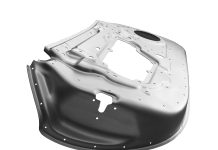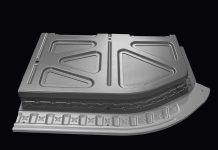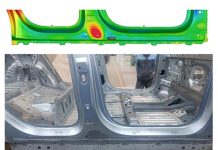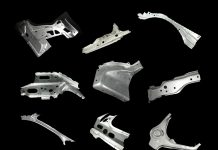A First Interview with More Interviews to Follow
As a part of our new blogging approach at AutoForm you’ll be seeing a number of interviews which bring our team to the forefront. You’ll get to know our team as we allow these figures to tell our story, through their own experience and successes in the world of simulation. Needless to say our high quality technical articles will continue to be delivered on the blog as well.
Expect soon to see interviews from managers, developers and software developers who share their favorite tools, current projects and thier insights into the greater sheet metal industry.
Today’s blog post features Stefan Davis, a Germany-based regional application engineer who was recently in Japan for the first time. While there he conducted a series of workshops Process Designer for CATIA while getting to know our Japanese customers.
AutoForm News had the opportunity to sit down with Mr. Davis afterwards.
Q1. Hi Stefan, please tell us a bit about yourself your job.
 I’ve been working in the automotive industry for quite some time. I first worked as a tool- and die-maker for about eight years; then I worked for 15 years as method planner and Tool Face and Tool Designer in a design company. I joined AutoForm four years ago.
I’ve been working in the automotive industry for quite some time. I first worked as a tool- and die-maker for about eight years; then I worked for 15 years as method planner and Tool Face and Tool Designer in a design company. I joined AutoForm four years ago.
The Process Designer for CATIA software is so powerful that you need to know a lot about Method Planning in Tool Design, and the use of CATIA in this area, to be able to convince customers of the many outstanding and innovative features and functions which can help them to do the same job in one 10th of the time, compared to the native CATIA product!
Now, as an application engineer on the Process Designer development team, I act as an intermediary between the development team and the market by helping customers take full advantage of our powerful software. Part of my job is to lead workshops, both internally and for customers. While I handle the European region, I also assist my American and Asian colleagues, and that’s what brought me to Japan.
Q2. What was the idea behind starting these workshops?
 We’ve done roadshows, general demonstrations, discussions, etc. – the usual, general marketing activities. But we felt that it was not enough. We thought that by conducting workshops that are hands-on and are tailored to customers’ specifications, we could better demonstrate our product’s strength and capabilities.
We’ve done roadshows, general demonstrations, discussions, etc. – the usual, general marketing activities. But we felt that it was not enough. We thought that by conducting workshops that are hands-on and are tailored to customers’ specifications, we could better demonstrate our product’s strength and capabilities.
The workshops started this year, and feedback has been very good so far. We’ve held them in Germany, Spain, and now, Japan. South Korea is on the list, too. Customers are impressed because our workshops are more than a set demonstration; we work with real cases provided by participating customers. This means that it becomes very real and relevant.
Q3. What’s a typical workshop like?
 It typically just lasts for a day, although participants have usually gone through basic training beforehand. Participants are mostly toolmakers, and their skill levels range from total beginners to experts who have worked with other systems. We usually just have a picture of a part to work with, so we really have to find specific solutions for our customers in time for the workshop. Each participant works on his/her computer, and I advise them as they go along. Like I said, the workshops are truly hands-on.
It typically just lasts for a day, although participants have usually gone through basic training beforehand. Participants are mostly toolmakers, and their skill levels range from total beginners to experts who have worked with other systems. We usually just have a picture of a part to work with, so we really have to find specific solutions for our customers in time for the workshop. Each participant works on his/her computer, and I advise them as they go along. Like I said, the workshops are truly hands-on.
We show them that they can work much, much faster with Process Designer than native CATIA. For example, designing a fender from scratch with CATIA Native takes 40-45 hours, but during our 3-day workshop in Spain, most of the design was done in 16 hours. In addition there were many discussion and explanation sessions as well.
Q4. What are the three most important features of Process Designer that you’d like to introduce?
First, our surface quality is superior to that of CATIA Native. This is a common headache for sheet engineers, but we have special developers that programmed the extrapolation functionality from scratch. Next, our update behavior is faster; it’s almost automatic, unlike in CATIA, in which part replacements are difficult to find.
So if a customer makes “last minute Parts design changes”, the update of his tool design is immediate and automatic, whereas in native CATIA he spends a considerable amount of time to have this job done.
Lastly, it is much easier to trace what kind of design steps have been made! With Process Designer the design files can easily be sent back and forth between customer and supplier, and both will immediately understand the concept behind the design. This is also true internally, within one company: It is very easy to take over the work from a colleague and continue where he or she stopped, and to follow the same concept, which becomes immediately transparent from the “tracing tree” of the AutoForm Process Designer.
Q5. How were the Japan workshops?
 Basically, there has been no significant difference in customer feedback among European, American, and Japanese companies. I’ve noticed that customers in Japan are very interested in what Europe and America do, as these regions are seen as case studies for the Japanese. We didn’t conduct the Japanese workshops differently from the way we conducted them in Europe and America.
Basically, there has been no significant difference in customer feedback among European, American, and Japanese companies. I’ve noticed that customers in Japan are very interested in what Europe and America do, as these regions are seen as case studies for the Japanese. We didn’t conduct the Japanese workshops differently from the way we conducted them in Europe and America.
Japanese participants were highly impressed and positively surprised at the ease of usage and time-saving quality of Process Designer. While all of the innovative features were generating plenty of interest, one function stood out in particular: automatic updates after changes in parts design. When a Parts Design Department has to make changes to a designed part, and if Tool Engineering has already made the design in CATIA Native or Process Designer, this convenient, easy-to-use function makes the changes almost automatically, whereas this takes a lot of time in CATIA Native.
Thank you Stefan Davis for taking the time to share insights into your work.
For our team, friends and followers, don’t forget to support our blog by leaving a comment.













